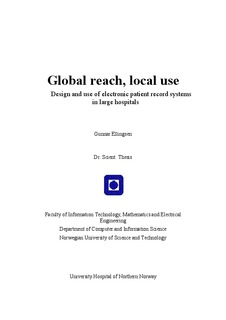| dc.contributor.author | Ellingsen, Gunnar Adelsten | nb_NO |
| dc.date.accessioned | 2014-12-19T13:30:25Z | |
| dc.date.available | 2014-12-19T13:30:25Z | |
| dc.date.created | 2003-01-28 | nb_NO |
| dc.date.issued | 2003 | nb_NO |
| dc.identifier | 125520 | nb_NO |
| dc.identifier.uri | http://hdl.handle.net/11250/249973 | |
| dc.description.abstract | The implementation of electronic patient records (EPRs) in large hospitals has for close to two decades been considered as a means for improving the exploitation of the health care resources. Both at the governmental level, in the hospitals, and in public institutions, there have been arguments about how an EPR should constitute a foundation for efficiency improvement, information systems integration and increased collaboration across departments and hospitals as well as for quality assurance in diagnostic work.
The results have so far been disappointing. Despite a series of heavily funded national and international initiatives, there has only been very modest success in establishing working Electronic Patient Records (EPRs) in large hospitals.
The present study looks more closely into this phenomenon and seeks to explore and explain why large projects often fail. Subsequently, I seek to suggest conditions and mechanisms for more successfully establishing working EPRs.
A large-scale EPR will unquestionably inscribe certain behaviour in organisational practice, which might result in failures caused by rigidity and inflexibility. On the other hand, the EPR might in itself behave in unforeseen ways or be used differently than initially planned, thus posing new challenges for designers. Accordingly, the design and implementation of large-scale EPRs are not merely a technical effort. Such a process must take into account that large hospitals are very complex organisations. Clinical work is highly specialised. It is characterised by state-of-the-art knowledge, high levels of education, but also by a very complex division of labour. The heterogeneous user-groups and professionals are very often recognised with different agendas and interests Broadly sketched, I address questions related to the organisation of large-scale IT-projects, strategies for integration of EPRs with existing IT-systems in hospitals, and strategies for how to perform standardisation processes. I also look into mechanisms for alternative organisation of work centred on EPRs. In addition, I discuss how the EPR might support collaboration among heterogeneous users in complex and specialised organisations.
From a theoretical point of view this study is based on the fields of Computer Supported Cooperative Work (CSCW), Science and Technology Studies in general and Actor Network Theory in particular (ANT). ANT offers an apparatus for describing and conceptualising the relationship between technological and social components. The CSCW literature has focused quite extensively on how an information system can support distributed collaborative work among groups of users. This is an important point related to the use of EPRs because real usefulness can only be achieved if the different professionals in the hospitals share some comprehension of what an EPR should do, and agree to use it in certain ways. The term 'information infrastructures' has been valuable in illustrating the complexity of organisations and IT-systems and how they are mutually intertwined. | nb_NO |
| dc.language | eng | nb_NO |
| dc.publisher | Fakultet for informasjonsteknologi, matematikk og elektroteknikk | nb_NO |
| dc.relation.haspart | Lærum, Hallvard; Ellingsen, Gunnar; Faxvaag, Arild. Doctors' use of electronic medical records systems in hospitals: cross sectional survey . British Medical Journal. 323(7325): 1344-1348, 2001. | nb_NO |
| dc.relation.haspart | Ellingsen, Gunnar Adelsten; Monteiro, E.. A Patchwork Planet Integration and Cooperation in Hospitals. (The original publication is available at www.springerlink.com) Computer Supported Cooperative Work (CSCW). 12(1): 71-95, 2003. | nb_NO |
| dc.relation.haspart | Ellingsen, Gunnar. Knowledge work in hospitals. IFIP WG 8.2, Global and Organizational Discourse about Information Technology ( In Wynn, E.H., Whitley, E.A., Meyers, M:D. and DeGross, J:I. (eds) Boston: Kluwer Academic Publishers, 2003. | nb_NO |
| dc.title | Global Reach, Local Use: Design and Use of Electronic Patient Record Systems in Large Hospitals | nb_NO |
| dc.type | Doctoral thesis | nb_NO |
| dc.contributor.department | Norges teknisk-naturvitenskapelige universitet, Fakultet for informasjonsteknologi, matematikk og elektroteknikk, Institutt for datateknikk og informasjonsvitenskap | nb_NO |
| dc.description.degree | dr.scient. | nb_NO |
| dc.description.degree | dr.scient. | en_GB |
